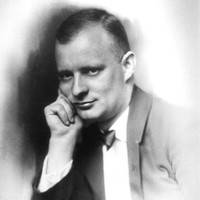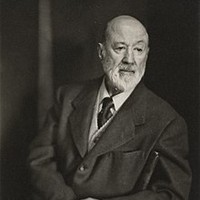Haydn and Hindemith
Sponsored By
- February 21, 2014

Sponsored By

 Listen to Audio
Listen to Audio
Paul Hindemith left his native Germany in 1938, after Nazi propagandists branded him a “standard-bearer of musical decay” and banned his music. After a short time in Switzerland, Hindemith moved to the United States in 1940 and secured a teaching position at Yale University, where he remained until 1953.
While in America, Hindemith reconnected with the heiress and arts patron Elizabeth Sprague Coolidge, who had commissioned the Concert Music for Piano, Brass, and Two Harps in 1930. Coolidge had funded an intimate auditorium at the Library of Congress in Washington, D.C., and the works she solicited from Bartók, Stravinsky, and others expressly for that compact stage resulted in some of the most important small-ensemble repertoire of the twentieth century. She approached Hindemith in 1944 about creating a ballet to be performed at the Coolidge Auditorium by Martha Graham; the subject was to be the Greek myth of Medea, with a detailed scenario sketched by Graham herself. Hindemith accepted the commission, but chose an entirely different subject, basing his work on a poem by Stéphane Mallarmé. The new work, Hérodiade, came together during two weeks of Hindemith’s summer vacation in New Haven, Connecticut. Graham and another member of her company gave the debut performance on October 30, 1944, on the same program that introduced Aaron Copland’s Appalachian Spring.
Mallarmé worked on the unfinished poem Hérodiade around 1864. The portion of the text that inspired Hindemith’s score takes the form of a dialogue between Herodias and her nurse. Historically, Herodias was the queen of Galilee in the first century A.D., and the mother of Salome (who, in some accounts, shares the name Herodias). The mother and daughter are infamous for their role in the execution of John the Baptist, a drama that formed the basis of Oscar Wilde’s Salome and the Richard Strauss opera of the same name. Mallarmé, for his part, described the title character of Hérodiade as neither a literal representation of Herodias or Salome but rather “a purely imaginary creature entirely independent of history.”
Hindemith’s use of text in Hérodiade was unusual in that he set the poetry to music, syllable-for-syllable, using purely instrumental forces to create an “orchestral recitation.” A note accompanying the score explains that this approach “would free the composer from the limitations of the human voice without renouncing its power of declamation and articulation.” The note goes on to explain the link between the musical technique and the poetic style:
"The melodies could be colored in ever changing tints, and the entire range from the double bass’ lowest tones to the flute’s highest could be used. Such a many-sided expansion of musical melody, although lacking the human directness of vocal expression but adorned with the polished and brittle artificiality of instrumental motion, would it not be the adequate means of accompanying Mallarmé’s wonderfully exalted but likewise polished, brittle and artificial creation?"
Hérodiade consists of eleven short movements, grouped into four main sections separated by short pauses. According to the publisher’s program note, “The Nurse is characterized by a soft tune in the string instruments while Hérodiade’s extremely erratic, expressive and symbolistic sentences are given to all the instruments, either in soloistic or ensemble form.”
Aaron Grad ©2014

Leaving behind the security of a steady (and stifling) position in his hometown of Salzburg, Mozart arrived in Vienna in 1781 to try his luck as a freelance musician. One way he generated income was by producing concerts and selling subscriptions; it was on these popular concerts that he introduced many of his compositions involving piano, including eleven new piano concertos completed in just 25 months, between February 1784 and March 1786. In the realm of opera, Mozart happily broke a four-year dry spell when he introduced The Marriage of Figaro on May 1, 1786. These years also saw Mozart’s increasing involvement in the realm of music composed expressly for publishing, including a commission for three piano quartets initiated by Franz Anton Hoffmeister in 1785.
Mozart’s first piano quartet for Hoffmeister, the work in G minor cataloged as K. 478, missed the mark; publications of such compositions were marketed toward amateur players for home use, and Mozart’s score was far too demanding. Hoffmeister canceled the contract, but Mozart still completed a second quartet in E-flat, written in the weeks after the Figaro premiere. He may have used it for one of his own concerts—possibly in a private performance in Prague in 1787, judging from a letter he wrote—and he was able to convince the rival publisher Artaria to release the quartet later that year.
The intensity of the E-flat Piano Quartet suggests that it would not have fared any better with amateurs than its G-minor predecessor. The piano writing in the Allegro first movement is full of surging octaves patterns in the left hand and running sixteenth-notes in the right, exhibiting a level of showmanship not far off from Mozart’s piano concertos from the same period. The Larghetto second movement opens up more melodic independence for the three strings as they trade leisurely phrases with the piano. The piano takes back the starring role in the Allegretto finale, but the strings have their fun, too, as in the copycat exchanges between the piano and violin.
Aaron Grad ©2014
 Listen to Audio
Listen to Audio
Charles Ives, who trained as a composer at Yale, resigned from his post as a church organist in 1902 and embraced the professional path of an insurance man. In the following decades he amassed a fortune, composed on evenings and weekends, and produced a singular body of music that went unheard by the public for most of his life.
Ives described The Unanswered Question, composed during his early years of musical independence, as a “cosmic drama.” Time slows down with the first sustained chord, a major triad spread wide throughout the strings. The harmonies unfold in a steady string chorale, a layer Ives characterized as “The Silences of the Druids — who Know, See and Hear Nothing.” Hovering in a different tempo and key, a lone trumpet poses “The Perennial Question of Existence,” a pensive anthem of mystery and wonder. A reproachful quartet offers “The Invisible Answer,” a dissonant and unstable retort that grows increasingly agitated with each response to the unwavering question. The trumpet intones the unknowable a final time, and the hushed string chorale fades away on the same mystical chord with which it began.
Aaron Grad ©2024

Following the death of Haydn’s longtime patron Prince Nikolaus Esterházy in 1790, the prince’s son and successor, Anton, curbed the family’s musical activities and reduced Haydn’s salary to a modest pension. Meanwhile, Johann Peter Salomon, a German violinist and impresario working in London, saw in Prince Nikolaus’s death an opportunity to lure the illustrious Haydn to England. Salomon offered Haydn a generous contract and, for the first time in decades, Haydn secured extended leave from his Esterházy service. Haydn composed six symphonies for his initial trip to London in 1791-92 and added six more for a follow-up visit in 1794-95.
Haydn and Salomon reached London on January 2, 1791. Haydn wrote, “My arrival caused a great sensation … I went the rounds of all the newspapers for three successive days. Everyone wants to know me.” Besides a busy schedule of socializing and teaching, Haydn prepared music for the upcoming spring concert season. Salomon’s orchestra of forty or so musicians offered mixed programs of symphonies, concertos, arias, and chamber music, appearing each Monday in London’s Hanover Square Rooms.
The Symphony No. 93, like all but one of the “London” symphonies, begins with a slow introduction. The initial unison notes and harmonic excursions into minor modes establish the symphony’s gravitas and build suspense for the arrival of the Allegro assai body of the movement, which enters with a fluid theme for strings in a three-beat meter. The music builds in intensity, through the rich counterpoint in the development section and the forceful arpeggios of the closing. The punch of the opening movement creates maximal contrast with the first sonority of the Largo cantabile, scored for just a string quartet. Surprises abound in this gentle movement, as in the shift to minor-key music graced with old-fashioned trills and dotted rhythms, or the downright flatulent blast from the bassoons in the midst of a delicate passage. (The audience demanded an encore of this movement at the first performance, proving that Haydn understood well the Londoners’ appetites for surprising, adventurous music.)
The minuet plays with a diverse palette of orchestral colors, including an unusual emphasis on the timpani, which continues into the contrasting trio section. The stomping upbeats and swooping grace-notes of the finale impart the feel of a rustic dance, but the subtle manipulations of the themes are the height of urbanity, crafted by a master at the peak of his powers for a clever audience that hung on his every move.
Aaron Grad ©2014
Please Note: The concert on Friday morning, February 21 at 10:30am will go on as scheduled. Please use caution and allow extra time for travel and parking.
Get driving directions and find nearby parking.
Find dining options close to the venue.
View seating charts to find out where you'll be seating.
Get driving directions and find nearby parking.
Find dining options close to the venue.
View seating charts to find out where you'll be seating.
